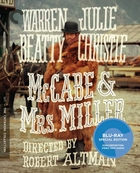BLU-RAY REVIEW

McCabe & Mrs. Miller
Featured In Issue 212, December 2016
Based on the novel McCabe by Edmund Naughton, McCabe & Mrs. Miller stars Warren Beatty and Julie Christie as two newcomers, one a gambler and the other a class prostitute, to the raw Pacific Northwest mining town of Presbyterian Church, who join forces to provide the miners with a superior kind of whorehouse experience. The appearance of representatives of a powerful mining company with interests of its own, however, threatens to be the undoing of their plans. (Gary Reber)
Special features include the 2002 commentary featuring Director Robert Altman and Producer David Foster; the documentary Way Out On A Limb (HD 54:38); four featurettes: Cari Beauchamp And Rick Jewell conversation (HD 36:27), Behind The Scenes (SD 09:32), Leon Ericksen (Production Designer) (SD 37:36), and Vilmos Zsigmond (Cinematographer) (SD 11:30); Steve Schapiro photo galleries; “The Dick Cavett Show” (SD 10:34); and the theatrical trailer.
The 2.38:1 1080p AVC picture is Kodak film sourced and very grainy due, no doubt, to its age (1971). According to Criterion, this new digital transfer was created in 4K 16-bit resolution on a Lasergraphics Director film scanner from the 35mm original camera negative. The color was matched to a reference print made by the Academy Film Archive of Motion Picture Arts and Sciences, and filmed by cinematographer Vilmos Zsigmond. Thousands of instances of dirt, debris, scratches, splices, and warps were manually removed using MTI's Film DRS, while Digital Vision's Phoenix was used for jitter, flicker, small dirt, grain, and noise management.
With all of the accolades noted above, this is still an undistinguished visual experience, though, definitely deserves merit due to its historic importance in filmmaking. I sure hope that the original color prints looked better than this, as this is extremely grainy, with poor shadow delineation. While the cinematography is an early work of Vilmos Zsigmond, the film's age has detracted from his unique visual style. Still, the visuals depict a rawness that perfectly captures the rugged Northwest territory as it might have appeared ages ago. Of course, compared to the previous LaserDisc and DVD release, this is a definite improvement—the best the film has ever looked on a home video format. Resolution is generally soft, but can exhibit detail during close-ups, such as in beards, fur coats, and object texture. The color palette exhibits warm hues throughout. Black levels are deep but lack detail. Fleshtones are generally natural in natural light. Overall, the visual feeling captures the rugged locations and period nicely, and fans should be pleased. (Gary Reber)
The LPCM 1.0 monaural soundtrack is also undistinguished and uneven in terms of atmospherics, Foley, and sound effects, which at times sound very forward and not well integrated spatially. Dialogue is intelligible but a bit distorted at times, perhaps due to the original source elements. Leonard Cohen's music often overpowers the other sound elements, interrupting the flow of the storytelling. Other music elements are nicely balanced. The original monaural soundtrack was remastered from the 35mm magnetic tracks. Clicks, thumps, hiss, hum, and crackle were manually removed using Pro Tools HD, AudioCube's integrated workstation, and iZotope RX4. (Gary Reber)

 then "Add to Home Screen"
then "Add to Home Screen"